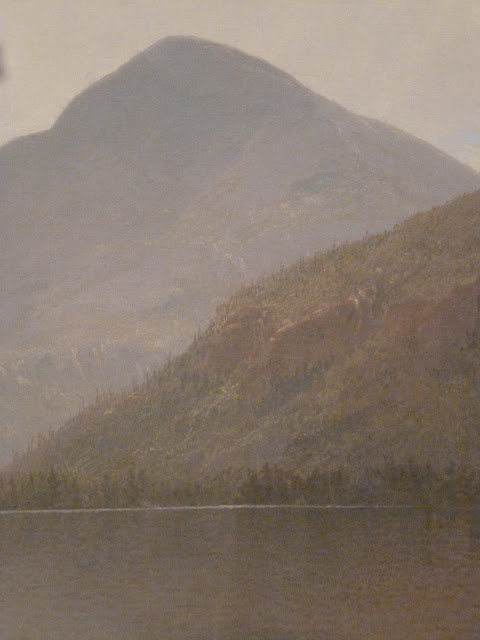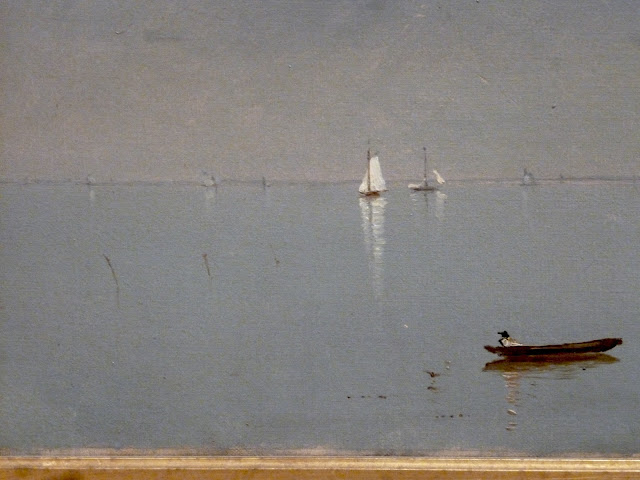Other artists rejected the dramatics of the Western wilderness for the more familiar and less spectacular inhabited landscapes of the Eastern USA. However these landscapes were no less spiritual for being longer inhabited. One of those artists was John Frederick Kensett. I've admired his work for years, but lately I've been spending a lot of time in the American wing of the Metropolitan Museum looking at it, as well as the work of a lot of other American landscape painters from the 19th century. Now that the USA is entering a post-imperial era, we need no longer make self-conscious comparisons to European painting anxious about our provinciality. We can finally appreciate the greatness inherent in this work whether or not it had anything to contribute to the development of modern form.
John Frederick Kensett was among the best, and perhaps the greatest of the group of landscape painters called "Luminists." He was a very establishment artist, though from humble origins. His father was an immigrant from England and worked as engraver. Kensett spent his youth working as an engraver like his father. With a couple of other aspiring artist friends, he raised the money to go to Europe to study. He spent seven years there, studying the work of Claude Lorraine in France and the 17th century Dutch landscapists, and especially Constable in England. He became quite a successful artist upon his return. Kensett was very well known, financially successful, and served on the boards of numerous arts organizations. He was a founder of the Metropolitan Museum in New York. He was on friendly terms with many of the most famous and influential people of the day. He was certainly not any marginalized visionary crank. And yet for all his success and fame, he was remarkably generous giving away a lot of his money to arts organizations, to support other struggling artists, and to various philanthropical organizations. Generosity cost him his life. He died after contracting pneumonia in an attempt to save Mary Lydia Hancock, wife of the artist Vincent Colyer, from drowning in Long Island Sound (alas, she died).
These are all my photos from the Metropolitan Museum except where noted. They are freely available, especially to educators.
Lake George, 1869
I've known this painting for many years, and it over time it has become one of my favorite paintings in the Metropolitan Museum. It is the exact opposite of the dramatic and bombastic spectacles of Church and Bierstadt in the next gallery (though I love their drama and bombast as eagerly as the next tourist). It is a calm luminous vision painted with self-effacing smooth transparent brushwork. It is a masterpiece of landscape as abstraction; superbly organized masses of light and dark tones. And yet, it is every bit as detailed as any Church painting of the South American jungles at the foot of the Andes.
This is the largest and probably the best of Kensett's many paintings of Lake George in the Adirondacks of New York.
It is well worth looking at closely in detail.
Lake George, Free Study, 1872
This is a study probably made on the spot, or finished in the studio. Kensett's painting of Lake George is as full of poetic license as anything that Bierstadt painted, and yet with so different an effect.
The gallery in the Met displaying Kensett's work contains mostly work from 1872, the last year of the artist's life, and one of his best and most productive. Most of these landscapes show the Connecticut shore of Long Island Sound where Kensett owned a home and studio. They are remarkable for their bare simplicity, their quiet, and their richly poetic suggestion. That emptiness filled with suggestion reminds me a lot of Chinese painting, especially Southern Song dynasty masters like Xia Gui. They also remind me of the spare emptiness of the work of the great German Romantic Caspar David Friedrich. Like Friedrich, Kensett takes mostly unremarkable scenery and makes it wondrous. Unlike Friedrich, Kensett doesn't depend on the evocative light of twilight. Some of Kensett's finest work in these paintings is lit by high noon.
Gathering Storm on Long Island Sound, 1872
Storms in Kensett's work are very different from the grand violent spectacles of artists like Turner or Bierstadt. Kensett paints the moment of quiet before the storm breaks. Instead of piling on the impasto and glazes thick, Kensett's paint remains thin and his brushwork self-effacing.
Eaton's Neck, Long Island, 1872
Robert Hughes compares this painting in its stark simplicity to the abstract paintings of Mark Rothko. That may be true in terms of the bareness of the composition devoid of any extra enlivening detail ("not even a seagull"). But this painting has none of the theatricality of Rothko's work. It is every bit as self-effacing in its stillness as Rothko's painting is self expressively dramatic with its dark voids and glowing lights.
I think Hughes is absolutely right when he says that anyone who has had any experience of the Sound will recognize the quality of light in this picture. The sense of tone and corresponding color is so exact in this painting.
As spare and calm as this painting is, it is filled with incident such as the tiny little view of the distant shore in this detail from the painting.
Passing Off the Storm, 1872
Twilight on the Sound, Darien, Connecticut, 1872
Sunset on the Sea, 1872
An amazingly bare painting devoid of any land references or ships..."not even a seagull."
Most of Kensett's work is fields of quietly glowing light like this usually inflected with landscape. In these last paintings, he shows the field of transparent light without the landscapes or incidents to give them scale and reference.
The Met is one of the few museums to make some of its storage and study collections available to the public. Much of the storage of the American wing is publicly accessible. The museum has many more of Kensett's works in storage and some really fine paintings; even more from that amazing year of 1872 on Long Island Sound. Unfortunately, they are all behind glass and so badly lit that they are hard to see, let alone photograph. Below is my photo of Kensett paintings in storage followed by two reproductions from the Met's website of pictures that I saw there.
Twilight in the Cedars, Darien, Connecticut, 1872, Photo from the Metropolitan Museum
Sunset, 1872, Photo from the Metropolitan Museum
The pleasures of Kensett's paintings are not the ecstatic raptures of Bierstadt or Church, nor are they quite the mystical reveries of Friedrich. They are closer to that more sober and temperate pleasure described by Ralph Waldo Emerson in his essay Nature:
The greatest delight which the fields and woods minister, is the suggestion of an occult relation between man and the vegetable. I am not alone and unacknowledged. They nod to me, and I to them. The waving of the boughs in the storm, is new to me and old. It takes me by surprise, and yet is not unknown. Its effect is like that of a higher thought or a better emotion coming over me, when I deemed I was thinking justly or doing right.
Yet it is certain that the power to produce this delight, does not reside in nature, but in man, or in a harmony of both. It is necessary to use these pleasures with great temperance. For, nature is not always tricked in holiday attire, but the same scene which yesterday breathed perfume and glittered as for the frolic of the nymphs, is overspread with melancholy today. Nature always wears the colors of the spirit.
John Frederick Kensett in 1866, photo from Wikipedia






























1 comment:
Very nice, Doug, thank you.
I thought of you twice today: 1) when my BFF showed me some of her efforts at painting mountains, and how she's having having someone help teach her. "Oh, my friend Doug could teach you", I said, thinking of your painting(s) set in Colorado. [Adding "Doug, you know, the art historian whom I referred you to re his website before {her daughter} left for study-abroad in Florence".] 2) As we were approaching AT&T Park again, I thought of last June! :-) [Sadly, the Giants lost AGAIN. It's been that kind of year, ultimately, I'm afraid.]
Post a Comment